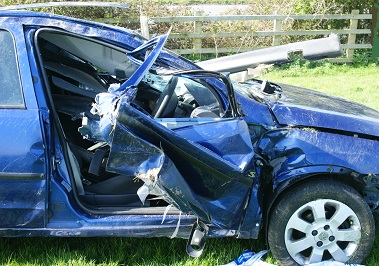Motorists that were behind the wheel and used their smartphones to snap images of a massive crash can find themselves in hot water.
While there are times in which technology news reveals many ways in which to improve our lives and make things easier, a recent situation in the United Kingdom has caused four drivers to be prosecuted for having taken photographs of a freeway accident using their mobile phones.
The Gloucestershire Police said that the activity of snapping the photos caused dangerous driving situations.
The police stated that the drivers in this technology news who took the photos of the traffic accident were so focused on taking the pictures that other drivers were required to hit the brakes or take other evasive action to avoid crashing into them. The drivers, who should have been focused on making sure that they were proceeding safely past the area of the crash, instead chose to take out their mobile phones and try to either photograph or take video footage of an RV that had collided with the center barrier of the M5 freeway, near Michaelwood services.
A police officer reported in this technology news that there were dozens of motorists trying to take pictures.
 The accident blocked the third lane of the freeway on the afternoon of July 28 and the many drivers who decided to focus on using their mobile devices to take pictures instead of concentrating on their own driving risked making the situation considerably worse. That said, among all of the motorists who failed to progress legally past the crash, only four were apprehended.
The accident blocked the third lane of the freeway on the afternoon of July 28 and the many drivers who decided to focus on using their mobile devices to take pictures instead of concentrating on their own driving risked making the situation considerably worse. That said, among all of the motorists who failed to progress legally past the crash, only four were apprehended.
Those four will be prosecuted for having driven without due care and attention, or without consideration to the other road users. That said, there were eight other drivers who were identified in this technology news story, and who will be sent letters of warning with regards to the way that they were using their mobile devices while behind the wheel.
According to a technology news statement released by PC Shelley Holloway, “The actions of several motorists who drove through the scene showed no regard for their own or of other people’s safety, as they used their mobile phones to record or video the wreckage as they passed.”
A new report issued by Transparency Market Research has revealed a very rapid wearables growth rate.
The figures published in a tech news report by Transparency market Research called “Wearable Technology Market – European Industry Analysis, Size, Share, Growth, Trends and Forecast, 2013 – 2019” have shown that while the wearables market was estimated to be worth $308.69 million, last year, the predicted growth rate will bring that stat to $2.54 billion by the close of 2019.
That represents a compound annual growth rate (CAGR) of 42.1 percent from this year through 2019.
The wearable technology marketplace currently holds a kind of niche position that is dominated by a handful of strong players. That said, additional participants are regularly stepping into this sector and are adding their own product contributions along the way. Still, the selections for consumers remain somewhat limited – when compared to the rest of the mobile tech offerings – and the price tags are still considered to be high enough to be prohibitive to major blocks of shoppers.
Equally, wearable technology is working its way into many marketplaces, some of which are seeing rapid growth.
 Wearables are finding their way into everything from military applications to industrial, and from medical and healthcare to fitness and wellness, and even simple infotainment. Moreover, as the number of wearable mobile devices continues to grow, so will their various applications. Development is rapidly continuing and the report predicts that this trend will be maintained throughout the forecast period.
Wearables are finding their way into everything from military applications to industrial, and from medical and healthcare to fitness and wellness, and even simple infotainment. Moreover, as the number of wearable mobile devices continues to grow, so will their various applications. Development is rapidly continuing and the report predicts that this trend will be maintained throughout the forecast period.
Among the products that are currently making headway in the wearable device market are smartwatches, augmented reality headsets and glasses, smart sports glasses, activity and fitness monitors, sleep sensors, and health and biometrics trackers. Various types of jewelry and clothing are also trying to crack their way into the space, but they are typically quite small and are the product of limited startups.
That said, many of the wearable technology devices that are catching on are only starting with their primary design purpose but are branching off into many other applications as consumers use them in their everyday lives. Many combination purpose devices are starting to be worn by early adopters.
 The accident blocked the third lane of the freeway on the afternoon of July 28 and the many drivers who decided to focus on using their mobile devices to take pictures instead of concentrating on their own driving risked making the situation considerably worse. That said, among all of the motorists who failed to progress legally past the crash, only four were apprehended.
The accident blocked the third lane of the freeway on the afternoon of July 28 and the many drivers who decided to focus on using their mobile devices to take pictures instead of concentrating on their own driving risked making the situation considerably worse. That said, among all of the motorists who failed to progress legally past the crash, only four were apprehended.
 Wearables are finding their way into everything from military applications to industrial, and from medical and healthcare to fitness and wellness, and even simple infotainment. Moreover, as the number of wearable mobile devices continues to grow, so will their various applications. Development is rapidly continuing and the report predicts that this trend will be maintained throughout the forecast period.
Wearables are finding their way into everything from military applications to industrial, and from medical and healthcare to fitness and wellness, and even simple infotainment. Moreover, as the number of wearable mobile devices continues to grow, so will their various applications. Development is rapidly continuing and the report predicts that this trend will be maintained throughout the forecast period.